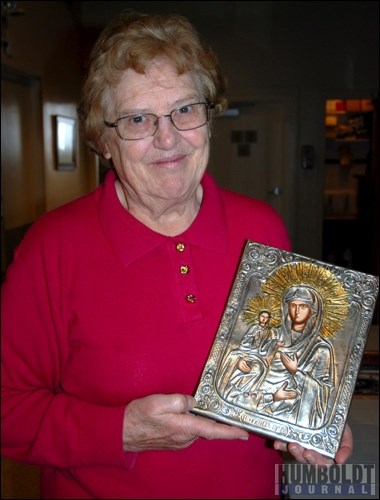Religious icons from all over the globe are in Humboldt this month.
Icons from the collection belonging to Louise and Percy Schmeiser of Bruno will fill two display cases at the Humboldt and District Museum and Gallery until after Easter.
Gathered over 30 years during the Schemeisers' trips around the globe, the icons hail from 17 different countries, most in eastern and continental Europe, as well as from Mexico.
The icons, which are paintings on canvas and wood, contain similar subject matter - Madonna and child, or saints - but they all look quite different. Some have precious metals like gold and silver, or contain semi-precious stones, while others are formed almost completely from wood, or are both carved and painted.
Not all of their 70-piece collection is up on display at the museum, but the show includes a good selection of their favourite pieces.
One of Louise's favourites is from Bulgaria and depicts the Blessed Virgin with three hands - one of them a miracle based on the story of St. John Damascene, who had a hand cut off, then had it miraculously restored.
Another favourite is from Mexico, called "Our Lady of Guadalupe."It shows the halo the Blessed Virgin usually has around her in Mexican art.
Another icon from Bulgaria has a large wooden frame showing scenes from the Bible, including the crucifixion, and one from Poland, the Lady of Chestanoba, carries slashes on her face. The story of the slashes dates back to an early invasion of Poland by the Swedes.
Louise began collecting these pieces when her husband gave her a present from a museum he visited in Jerusalem. Knowing his wife's devotion to the Blessed Virgin, Percy had purchased an icon the museum was selling from its collection. Their collection grew from that point.
Because the two travel a lot, they had opportunities to pick more up, Percy noted. They were easy to carry, and as long as they had the proper documents, easy to take out of the country they were visiting.
Some of the icons are extremely old, Percy claims. The oldest he believes is about 1,000 years old, from Ethiopia. The newest, they said, was made in the 1950s - a tapestry celebrating the anniversary of the Virgin appearing in Lourdes.
"They are all at least 50 to 100 years old," Percy said.
Prints of various icons are available, Percy noted, but they wanted originals. So they buy them straight from churches or museums - stores don't carry them.
They wanted to bring back these pieces of heritage, he added, so that people here would be able to see them.
And now you can, until just after Easter.




